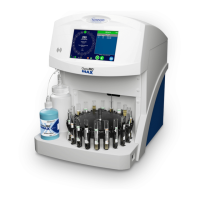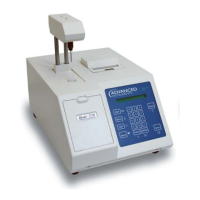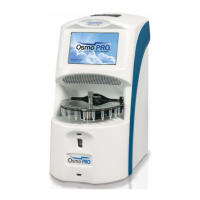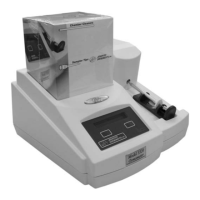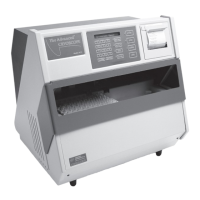The OsmoPRO
®
Micro-Osmometer Service Manual
26
RS-232 Driver Circuits:
The instrument uses 3 RS-232 ports: Communication to display PCB, communication to scanner and
communication to printer; a transceiver IC handles the level translation of all 3 ports.
Osmometer Module Circuits
The osmometer circuits control three 12 VDC stepper motors used to rotate the turntable and
engage/disengage the cooling block with the sample probe; three fans are used to exhaust air from the
power box, remove heat from the TEC module and exhaust warm air accumulating at the top of the
instrument; three optical sensors are used to control the motor positions; three proximity sensors are
used to determine the presence of sample tubes, turntable objects near the bar code scanner, thermoelec-
tric module cooling, activation of the solenoid and the A/D reading of the Wheatstone bridge circuits of
the sample probe and block probe.
DISPLAY ASSEMBLY, P/N 112022
The display assembly functions as the main user interface controller and connectivity to the USB and
ethernet peripherals. It contains the display PCB and color LCD screen, resistive touch element and the
USB/ethernet extension cables. The assembly is secured underneath the top of the instrument’s bezel
cover.
7” Color/Touch LCD Screen:
The OsmoPRO instrument has a 7” WVGA (800 x 480) LCD/touch screen built into the display assem-
bly. It has a metal gasket used to reduce radiated electrical emissions. The LCD screen has a built-in
four-wire resistive touch screen overlay.
Display PCB (112021PC):
The display PCB contains a high power IMX6 micro-processor running a real-time operating system
(RTOS) from Mentor Graphics called “Nucleus.” It is used to interact with the color/touch LCD screen
and to provide the following serial interfaces to the control PCB: Four (4) - USB ports, one (1) - ether-
net port and one (1) - RS-232 port.
Interfaces:
The display PCB has the following interfaces:
RS-232 (1x) - This serial interface communicates commands and data to/from the control PCB.
USB 2.0 (2x) - Type A interfaces to attach to rear of instrument via internal shielded USB cables to USB
adapter.
USB 2.0 (1x) - Type B interface to attach to rear of instrument via internal shielded USB cable to USB
adapter.
USB 2.0 (1x) - Type A interface to attach to front of instrument via internal, shielded USB cable to USB
adapter.
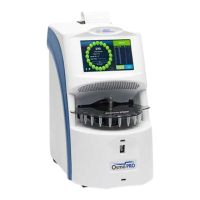
